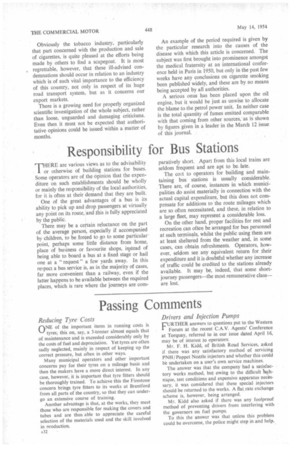Exhaust-Gas Fallacies Exploded
Page 33

Page 34

If you've noticed an error in this article please click here to report it so we can fix it.
ACURIOUS development following the recent report from America that lung cancer is largely caused by smoking, is a whole series of attacks upon oil-engined vehicles, accusing the exhaust gases from these as being the major cause of the increasing prevalence of this disease. Many of these are wild statements from persons quite unqualified to make them, but there are others for which doctors are responsible, but even doctors can make wrong diagnoses, particularly when they are not specialists in the alleged causes concerned.
In the Hunt f the Oil Eng Blamed for
It may well be asked how many of them are indeed specialists in respect of the constitution of exhaust fumes and the possible effects of those upon the human body.
A doctor said at Bristol—a centre of the tobacco trade—that the exhaust fumes from oil engines were far more dangerous than those from petrol, and he called for action in combating them. He did not think that cigarette smoking was a cause of lung cancer, thereby exposing a wide divergence of opinion in the medical profession. He asked what had been added to make London fog and smog so deadly, himself giving the answer that he could think of nothing except the fumes from public transport (which, now, is mainly by oilengined vehicles). The remedy, he added, was to make the combustion complete.
Oil Fuel Thoroughly Burnt Now if he had had extensive technical knowledge of the differences between the various types of power unit, he would have known that one of the major reasons for the greater efficiency of the compression-ignition engine is that its economy is largely derived from the fact that the oil fuel it employs is more thoroughly consumed than in any other engine. In this respect it is better than the petrol unit, and produces little or no carbon monoxide.
The doctor, in an effort to prove his case, said that the increase in the disease during the past 30 years showed that it almost entirely followed the cutra,e of the changeover of public transport from petrol to oil engines.
That is a nonsensical state ment, for this alleged change over did not develop, even in our big cities, to any considerable extent until many years after 1924.
The first bus to be equipped with an oil engine was put into service in 1930, but even towards the end of 1935, there were only 1.000 oil-engined buses in service in London, the number increasing to 2,000 early in 1937. It is necessary therefore to look for some other cause of the rise for the many years before these vehicles became so numerous as to exercise any possible appreciable effect upon atmospheric conditions.
Smoke From Chimneys Other people have suggested that the dangerous constituent of the exhaust from oil engines is sulphur dioxide. There is, however, very little sulphur in dery and the amoulit of this gas produced by hundreds of engine exhausts would probably be far less than would issue from a single smoking chimney of a private house in which coal of poor quality was being used. In any case. investigations over a long period of years have appeared to show that tarry products are more conducive to the disease than any others. Where coal is burnt wastefully, these products form an important constituent of the resulting smoke.
The majority of the oil engines in vehicles is well maintained, consequently only a small proportion of the total in service emit black smoke beyond perhaps occasional puffs.
To the analytical mind, it might well appear more probable that the curve showing the rise in lung cancer has been coincidental with the steadily increasing congestion of the population in our chief living centres. This has meant a much greater number of individual establishments per square mile, a tendency which is still growing as more houses are built and add their quota to the volume of smoke.
A further proof that oil-engined vehicles are not responsible for the danger is afforded by recent tests in two Thames tunnels. From the danger point of view, these proved entirely negative. Obviously the tobacco industry, particularly that part concerned with the production and sale of cigarettes, is quite pleased at the efforts being made by others to find a scapegoat. It is most , regrettable, however, that these ill-advised condemnations should occur in relation to an industry which is of such vital importance to the efficiency of this country, not only in respect of its huge road transport system, but as it concerns our export markets.
There is a growing need for properly organized scientific investigation of the whole subject, rather than loose, unguarded and damaging criticisms. Even then it must not be expected that authoritative opinions could be issued within a matter of months. An example of the period required is given by the particular research into the causes of the disease with which this article is concerned. The subject was first brought into prominence amongst the medical fraternity at an international conference held in Paris in 1950, but only in the past few weeks have any conclusions on cigarette smoking been published widely, and these are by no means being accepted by all authorities.
A serious onus has been placed upon the oil engine, but it would be just as unwise to allocate the blame ta the petrol power unit. In neither case is the total quantity of fumes emitted comparable with that coming from other sources, as is shown by figures giyen in a leader in the March 12 issue of this journal.




































































































